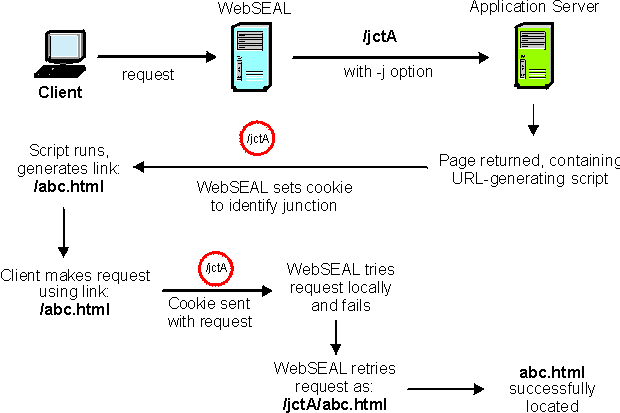Junction cookie concepts
HTML pages from back-end junctioned application servers can contain embedded applets or scripts that dynamically generate server-relative links on the client-side. WebSEAL cannot filter these URLs because they are dynamically generated on the client-side. Therefore, these server-relative URLs are expressed without knowledge of the junction point where the application server resides. This section describes a cookie-based solution to modifying server-relative URLs dynamically generated on the client-side. When a client receives a page from a junctioned server, and requests a resource using a dynamically generated server-relative URL on this page, WebSEAL can attempt to reprocess the URL using a special cookie. The cookie contains the appropriate junction information. This solution requires that we initially create the junction to the back-end application server using the -j option.
- Client makes a request for an HTML page from a back-end junctioned application server.
In addition to other content, the page contains an embedded applet that generates a server-relative URL once the page is loaded on the client's browser.
- The page is returned to the client across the junction created with the -j option.
The -j option causes WebSEAL to prepend a JavaScript block at the beginning of the HTML page.
The purpose of the JavaScript is to set a junction-identifying cookie on the browser.
- When the page is loaded on the client's browser, the JavaScript runs
and sets the junction-identifying cookie in the browser's cookie cache.
The cookie is a session cookie containing the name of the junction.
- The embedded applet on the page dynamically runs and generates the server-relative URL.
- The client makes a request for a resource using this server-relative URL. The junction cookie
information is sent as an HTTP header in this request:
- IV_JCT = /junction-name
- Because the server-relative URL in the client request has not been filtered, it appears to WebSEAL as a request for a local resource.
- When it fails to locate the resource locally, WebSEAL immediately retries the request using the junction information supplied by the cookie.
- With the correct junction information in the URL expression, the resource is successfully located on the back-end application server.
Parent topic: Modification of server-relative URLs with junction cookies
